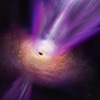| Apr 26, 2023 |
|
|
|
(Nanowerk News) An international team of scientists led by Dr. LU Rusen from the Shanghai Astronomical Observatory (SHAO) of the Chinese Academy of Sciences has used new millimeter-wavelength observations to produce an image that shows, for the first time, both the ring-like accretion structure around a black hole, where matter falls into the black hole, and the black hole’s associated powerful relativistic jet. The source of the images was the central black hole of the prominent radio galaxy Messier 87.
|
|
The study was published in Nature (“A ring-like accretion structure in M87 connecting its black hole and jet”).
|
 |
| Artist’s conception shows a close-up view of the accretion flow and the jet emerging from the black hole region in Messier 87. (Image: Sophia Dagnello, NRAO/AUI/NSF)
|
|
The image underlines for the first time the connection between the accretion flow near the central supermassive black hole and the origin of the jet. The new observations were obtained with the Global Millimeter VLBI Array (GMVA), complemented by the phased Atacama Large Millimeter/submillimeter Array (ALMA) and the Greenland Telescope (GLT). The addition of these two observatories has greatly enhanced the imaging capabilities of the GMVA.
|
|
“Previously, we had seen both the black hole and the jet in separate images, but now we have taken a panoramic picture of the black hole together with its jet at a new wavelength,” said Dr. LU.
|
|
The surrounding material is thought to fall into the black hole in a process known as accretion. But no one had ever imaged it directly.
|
|
According to LU, the ring that was seen before was becoming larger and thicker at the 3.5 mm observing wavelength. “This shows that the material falling into the black hole produces additional emission that is now observed in the new image. This gives us a more complete view of the physical processes acting near the black hole,” said LU.
|
|
The participation of ALMA and GLT in the GMVA observations and the resulting increase in resolution and sensitivity of this intercontinental network of telescopes has made it possible to image the ring-like structure in M87 for the first time at the 3.5 mm wavelength. The diameter of the ring measured by the GMVA is 64 microarcseconds, which corresponds to the size of a small (5-inch/13-cm) selfie ring light on Earth as seen by an astronaut on the Moon. This diameter is 50 percent larger than what was seen in observations by the Event Horizon Telescope at 1.3 mm, in accordance with expectations for the emission from relativistic plasma in this region.
|
 |
| Millimeter-VLBI image of the jet and the black hole in Messier 87, obtained with the GMVA array plus ALMA and the Greenland Telescope. (Image: LU Rusen, SHAO; E. Ros, MPIfR; and S. Dagnello, NRAO/AUI/NSF)
|
|
“With the greatly improved imaging capabilities by adding ALMA and GLT into GMVA observations, we have gained a new perspective. We do indeed see the triple-ridged jet that we knew about from earlier VLBI observations,” said Thomas Krichbaum of the Max Planck Institute for Radio Astronomy (MPIfR) in Bonn. “But now we can see how the jet emerges from the emission ring around the central supermassive black hole and we can measure the ring diameter also at another (longer) wavelength.”
|
|
The light from M87 is produced by the interplay between highly energetic electrons and magnetic fields, a phenomenon called synchrotron radiation. The new observations, at a wavelength of 3.5 mm, reveal more details about the location and energy of these electrons. They also tell us something about the nature of the black hole itself: It is not very hungry. It consumes matter at a low rate, converting only a small fraction of it into radiation.
|
|
According to Keiichi Asada from the Institute of Astronomy and Astrophysics of Academia Sinica, “To understand the physical origin of the bigger and thicker ring, we had to use computer simulations to test different scenarios. As a result, we concluded that the larger extent of the ring is associated with the accretion flow.”
|
|
Kazuhiro Hada from the National Astronomical Observatory of Japan noted that the team also found something “surprising” in their data. “The radiation from the inner region close to the black hole is broader than we expected. This could mean that there is more than just gas falling in. There could also be a wind blowing out, causing turbulence and chaos around the black hole,” said Hada.
|
|
The quest to learn more about Messier 87 is not over, as further observations and a fleet of powerful telescopes continue to unlock its secrets. “Future observations at millimeter wavelengths will study the time evolution of the M87 black hole and provide a polychromatic view of the black hole with multiple color images in radio light,” said Jongho Park of the Korea Astronomy and Space Science Institute.
|




